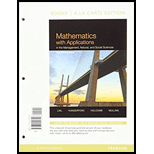
Concept explainers
Work these exercises.
Checkout Lines According to the article “How to Pick the Fastest Line at the Supermarket,” the amount of time (in seconds) you will be waiting in a checkout line has been approximated by Dan Meyer to be 41 seconds for each person in line ahead of you plus 3 seconds for each item ahead of you. (Data from: The New York Times, September 7,2016)
a. Find a formula
b. Find your waiting time in an express checkout line that has 5 people ahead of you, and each person has 10 items.
c. Find your waiting time in a regular checkout line that has only 2 people ahead of you, but each person has 40 items.
d. Is the express line in part (b) faster than the regular checkout line in part (c)?
Want to see the full answer?
Check out a sample textbook solution
Chapter 14 Solutions
MATH W/APPLICAT.W/NOTES GDE +ACCESS CODE
- According to an economist from a financial company, the average expenditures on "furniture and household appliances" have been lower for households in the Montreal area than those in the Quebec region. A random sample of 14 households from the Montreal region and 16 households from the Quebec region was taken, providing the following data regarding expenditures in this economic sector. It is assumed that the data from each population are distributed normally. We are interested in knowing if the variances of the populations are equal. a) Perform the appropriate hypothesis test on two variances at a significance level of 1%. Include the following information: i. Hypothesis / Identification of populations ii. Critical F-value(s) iii. Decision rule iv. F-ratio value v. Decision and conclusion b) Based on the results obtained in a), is the hypothesis of equal variances for this socio-economic characteristic measured in these two populations upheld? c) Based on the results obtained in a),…arrow_forwardPlease plot graphs to represent the functionsarrow_forwardEXAMPLE 6.2 In Example 5.4, we considered the random variables Y₁ (the proportional amount of gasoline stocked at the beginning of a week) and Y2 (the proportional amount of gasoline sold during the week). The joint density function of Y₁ and Y2 is given by 3y1, 0 ≤ y2 yı≤ 1, f(y1, y2) = 0, elsewhere. Find the probability density function for U = Y₁ - Y₂, the proportional amount of gasoline remaining at the end of the week. Use the density function of U to find E(U).arrow_forward
- 7.20 a If U has a x² distribution with v df, find E(U) and V (U). b Using the results of Theorem 7.3, find E(S2) and V (S2) when Y₁, Y2,..., Y, is a random sample from a normal distribution with mean μ and variance o².arrow_forwardAccording to a survey conducted by the American Bar Association, 1 in every 410 Americans is a lawyer, but 1 in every 64 residents of Washington, D.C., is a lawyer. a If you select a random sample of 1500 Americans, what is the approximate probability that the sample contains at least one lawyer? b If the sample is selected from among the residents of Washington, D.C., what is the ap- proximate probability that the sample contains more than 30 lawyers? c If you stand on a Washington, D.C., street corner and interview the first 1000 persons who walked by and 30 say that they are lawyers, does this suggest that the density of lawyers passing the corner exceeds the density within the city? Explain.arrow_forward7.50 Shear strength measurements for spot welds have been found to have standard deviation 10 pounds per square inch (psi). If 100 test welds are to be measured, what is the approximate probability that the sample mean will be within 1 psi of the true population mean? 7.51 Refer to Exercise 7.50. If the standard deviation of shear strength measurements for spot welds is 10 psi, how many test welds should be sampled if we want the sample mean to be within 1 psi of the true mean with probability approximately 992arrow_forward
- 8.12 The reading on a voltage meter connected to a test circuit is uniformly distributed over the interval (0, +1), where 0 is the true but unknown voltage of the circuit. Suppose that Y₁, Y2,..., Y, denote a random sample of such readings. a Show that Y is a biased estimator of and compute the bias. b Find a function of Y that is an unbiased estimator of 0. C Find MSE(Y) when Y is used as an estimator of 0.arrow_forwardx 1.1 1.2 1.3 f 3.1 3.9 य find numerical f'(1) by using approximation.arrow_forwardNo chatgpt pls will upvote Already got wrong chatgpt answer Plz no chatgpt downvote.arrow_forward
- Q/Let G be a simple graph-show that if Gis not connected, then it is complement is Connected.arrow_forwardQ/prove that if d (u,v) >2 then there is a vertex z in G st. d (u,v) = d(u, z)+d(z₁v)arrow_forwardT Figure E Statement 33 33° H 40 R 37° 83° S T 55 45 K S 30 U 44 87 H 56 36 ° 54 F 83° 66 P 33 87° ° I 42 200 Rarrow_forward
 Holt Mcdougal Larson Pre-algebra: Student Edition...AlgebraISBN:9780547587776Author:HOLT MCDOUGALPublisher:HOLT MCDOUGAL
Holt Mcdougal Larson Pre-algebra: Student Edition...AlgebraISBN:9780547587776Author:HOLT MCDOUGALPublisher:HOLT MCDOUGAL Glencoe Algebra 1, Student Edition, 9780079039897...AlgebraISBN:9780079039897Author:CarterPublisher:McGraw Hill
Glencoe Algebra 1, Student Edition, 9780079039897...AlgebraISBN:9780079039897Author:CarterPublisher:McGraw Hill Functions and Change: A Modeling Approach to Coll...AlgebraISBN:9781337111348Author:Bruce Crauder, Benny Evans, Alan NoellPublisher:Cengage Learning
Functions and Change: A Modeling Approach to Coll...AlgebraISBN:9781337111348Author:Bruce Crauder, Benny Evans, Alan NoellPublisher:Cengage Learning- Algebra & Trigonometry with Analytic GeometryAlgebraISBN:9781133382119Author:SwokowskiPublisher:Cengage
 Algebra: Structure And Method, Book 1AlgebraISBN:9780395977224Author:Richard G. Brown, Mary P. Dolciani, Robert H. Sorgenfrey, William L. ColePublisher:McDougal Littell
Algebra: Structure And Method, Book 1AlgebraISBN:9780395977224Author:Richard G. Brown, Mary P. Dolciani, Robert H. Sorgenfrey, William L. ColePublisher:McDougal Littell Elementary AlgebraAlgebraISBN:9780998625713Author:Lynn Marecek, MaryAnne Anthony-SmithPublisher:OpenStax - Rice University
Elementary AlgebraAlgebraISBN:9780998625713Author:Lynn Marecek, MaryAnne Anthony-SmithPublisher:OpenStax - Rice University





